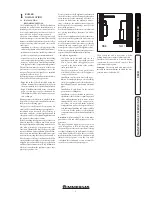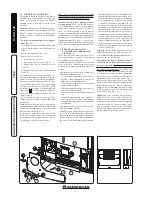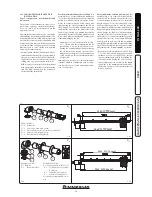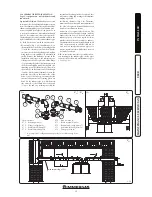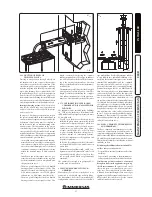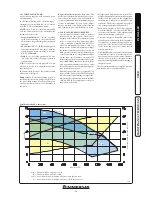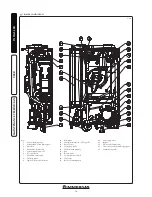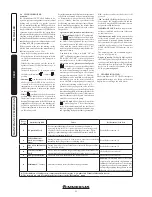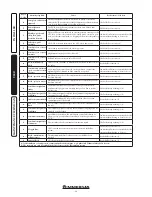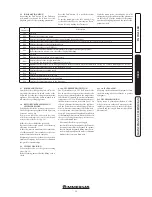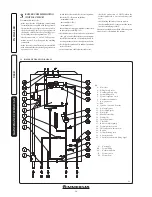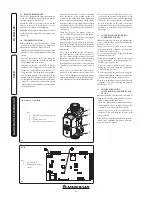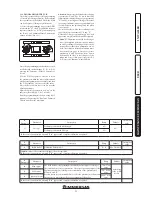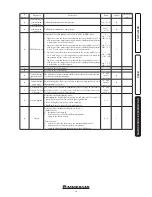
18
1-27
INS
T
ALLER
US
ER
MAINTEN
AN
CE TECHNI
CI
AN
1.20 WATER TREATMENT SYSTEM
FILLING.
As already mentioned in the previous para-
graphs, a chemical treatment of the thermal
system water is required, in compliance with the
local standards in force.
The parameters that influence the duration and
proper operation of the heat exchanger are the
water's PH, hardness, conductivity, and oxygen,
together with the system's processing residues
(any welding residues), any oil present and cor-
rosion products that can, in turn, cause damage
to the heat exchanger.
In order to prevent this from happening, you are
recommended to:
- Before installation on new systems as well as
old ones, clean the system with clean water to
eliminate solid residues contained therein.
- Clean the system with a chemical treatment:
- Clean the new system with a suitable cleaning
device (for example Sentinel X300, Fernox
Cleaner F3 or Jenaqua 300) combined with
thorough washing.
- Clean the old system with a suitable cleaning
device (for example Sentinel X400 or X800,
Fernox Cleaner F3 or Jenaqua 400) combined
with thorough washing.
- Check the maximum hardness and quantity
of filling water referring to the graphics (Fig.
1-27). If the contents and hardness of the water
are below the indicated curve, no specific treat-
ment is required; otherwise, to limit the content
of calcium carbonate, you must provide for
water-filling treatment.
- For filling, you are not allowed to use water
softened with the use of ionic-exchange resins
or distilled water.
- Should you be required to provide for water
treatment, this should be carried out by
completely desalinating the filling water. As
opposed to the complete softening process,
desalinating the water completely not only
removes hardening agents (Ca, Mg), but also
eliminates all other minerals to reduce water-
filling conductivity up to 10 microsiemens/
cm. Given its low conductivity, desalinated
water does not only prevent the formation of
lime scale, but also serves as protection against
corrosion.
- Insert a suitable inhibitor / passivator (for
example Sentinel X100, Fernot Protector F1,
or Jenaqua 100); if required, also insert appro-
priate antifreeze (such as for example Sentinel
X500, Fernox Alphi 11 or Jenaqua 500).
- Check electrical conduction of the water, which
should be higher than 2000
µ
s/cm in the case
of treated water and lower than 600
µ
s/cm in
the case of non-treated water.
- To prevent corrosion, the water system's PH
should be between 6.5 and 8.5.
- Check the maximum content of chlorides,
which should be less than 250 mg/l.
N.B.:
for quantities and methods of use of water-
treatment products, refer to the instructions
provided by their manufacturer.
1.21 SYSTEM FILLING.
Once the boiler is connected, proceed with
system filling via the filling cock (Fig. 1-29 and
1-3). Filling is performed at low speed to ensure
release of air bubbles in the water via the boiler
and heating system vents.
The boiler has a built-in automatic venting valve
on the circulator.
Check if the cap is loose.
Open the
radiator vent valves.
Close radiator vent valves when only water
escapes from them.
Close the filling cock when the boiler pressure
gauge indicates approx. 1.2 bar.
N.B.:
during these operations, enable the au-
tomatic vent functions on the boiler (active on
first ignition).
1.22 CONDENSATE TRAP FILLING.
On first lighting of the boiler, flue gas may come
out the condensate drain; after a few minutes’
operation check that this no longer occurs. This
means that the drain trap is filled with conden-
sate to the correct level preventing the passage
of flue gas.
1.23 GAS SYSTEM START
-
UP.
To start up the system, refer to the technical
standard in force: This divides the systems and
therefore the start-up operations into three
categories: new systems, modified systems, re-
activated systems.
In particular, for new gas systems:
- open windows and doors;
- avoid presence of sparks or open flames;
- bleed all air from the pipelines;
- check that the internal system is properly sealed
according to the specifications set forth by
technical regulations in force.
1.24 BOILER START UP
(
IGNITION
)
.
In order to issue the Declaration of Conformity
required by the laws in force, the following re-
quirements must be fulfilled to commission the
boiler (the operations listed below must only be
performed by a qualified firm and without any
unauthorised persons):
- check that the internal system is properly sealed
according to the specifications set forth by
technical regulations in force;
- ensure that the type of gas used corresponds to
the boiler settings (the type of gas appears on
the display on first electrical supply voltage, or
by checking the relative parameter “G”);
- check connection to a 230V-50Hz power
mains, correct L-N polarity and earthing con-
nection;
- check that there are external factors that may
cause the formation of fuel pockets;
- switch the boiler on and check correct ignition;
- make sure that the gas flow rate and relevant
pressure values comply with those given in the
manual (Par. 3.22);
- ensure that the safety device intervenes in the
event of gas supply failure and check the relative
intervention time;
- check the intervention of the main switch
located upstream from the boiler and in the
boiler;
- check that the intake/exhaust concentric ter-
minal (if fitted) is not blocked.
- Carry out the flue test and set the relative
parameter "F0".
The boiler must not be started up even if only
one of the checks should be negative.
N.B.:
only upon completing commissioning by
an installer, may an authorised firm carry out an
initial inspection of the boiler, which is required to
activate the Immergas warranty. The test certificate
and warranty is issued to the user.
N.B.:
the graph refers to the
entire life cycle of the system.
Therefore, also consider sched-
uled and unscheduled mainte-
nance, which involves emptying
and filling the said system.
Water hardness °F
Sys
tem w
at
er l
it
re
s
Summary of Contents for VICTRIX MAIOR 28 - 35 TT 1 ERP
Page 1: ...VICTRIX MAIOR 35 X TT 1 ERP IE Instruction and recommendation booklet 1 038660ENG...
Page 2: ......
Page 46: ...46...
Page 47: ...47...


